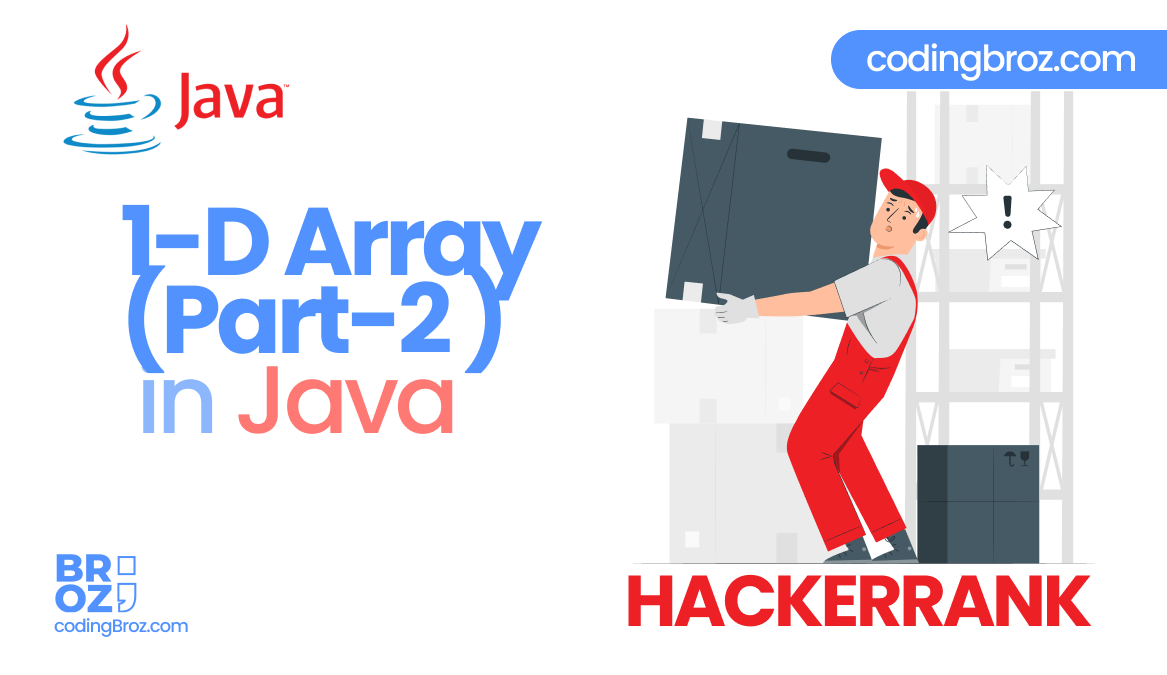Hello coders, today we are going to solve Java 1D Array (Part 2) HackerRank Solution.

Problem
Let’s play a game on an array! You’re standing at index 0 of an n-element array named game. From some index i(where 0 <= i < n), you can perform one of the following moves:
- Move Backward: If cell i-1 exists and contains a 0, you can walk back to cell i-1.
- Move Forward:
- If cell i+1 contains a zero, you can walk to cell i+1.
- If cell i + leap contains a zero, you can jump to cell i + leap.
- If you’re standing in cell n-1 or the value of i + leap >= n, you can walk or jump off the end of the array and win the game.
In other words, you can move from index i to index i + 1, i – 1, or i + leap as long as the destination index is a cell containing a 0. If the destination index is greater than n-1, you win the game.
Function Description
Complete the canWin function in the editor below.
canWin has the following parameters:
- int leap: the size of the leap
- int game[n]: the array to traverse
Returns
boolean: true if the game can be won, otherwise false
Input format
The first line contains an integer, q, denoting the number of queries (i.e., function calls).
The 2 . q subsequent lines describe each query over two lines:
- The first line contains two space-separated integers describing the respective values of n and leap.
- The second line contains n space-separated binary integers (i.e., zeroes and ones) describing the respective values of game0 , game1, game2, ….. , gamen-1.
Constraints
- 1 <= q <= 5000
- 2 <= n <= 100
- 0 <= leap <= 100
- It is guaranteed that the value of game[0] is always 0.
Sample Input
STDIN Function
----- --------
4 q = 4 (number of queries)
5 3 game[] size n = 5, leap = 3 (first query)
0 0 0 0 0 game = [0, 0, 0, 0, 0]
6 5 game[] size n = 6, leap = 5 (second query)
0 0 0 1 1 1 . . .
6 3
0 0 1 1 1 0
3 1
0 1 0Sample Output
YES
YES
NO
NOExplanation
We perform the following q = 4 queries:
- For game = [0, 0, 0, 0, 0] and leap = 3, we can walk and/or jump to the end of the array because every cell contains a 0. Because we can win, we return true.
- For game = [0, 0, 0, 1, 1, 1] and leap = 5, we can walk to the index 1 and then jump i + leap = 1 + 5 = 6 units to the end of the array. Because we can win, we return true.
- For game = [0, 0, 1, 1, 1, 0] and leap = 3, there is no way for us to get past the three consecutive ones. Because we cannot win, we return false.
- For game = [0, 1, 0] and leap = 1, there is no way for us to get past the one at index 1. Because we cannot win, we return false.
Solution – Java 1D Array (Part 2)
import java.util.*;
public class Solution {
public static boolean find_path(int leap, int[] game, int x) {
if (x < 0) {
return false;
}
if (x > game.length - 1) {
return true;
}
if (game[x] != 0) {
return false;
}
game[x] = 5;
if (find_path(leap, game, x + 1)) {
return true;
}
if (find_path(leap, game, x + leap)) {
return true;
}
if (find_path(leap, game, x - 1)) {
return true;
}
game[x] = 0;
return false;
}
public static boolean canWin(int leap, int[] game) {
return find_path(leap, game, 0);
}
public static void main(String[] args) {
Scanner scan = new Scanner(System.in);
int q = scan.nextInt();
while (q-- > 0) {
int n = scan.nextInt();
int leap = scan.nextInt();
int[] game = new int[n];
for (int i = 0; i < n; i++) {
game[i] = scan.nextInt();
}
System.out.println( (canWin(leap, game)) ? "YES" : "NO" );
}
scan.close();
}
}
Disclaimer: The above Problem ( Java 1D Array (Part 2) ) is generated by Hacker Rank but the Solution is Provided by CodingBroz. This tutorial is only for Educational and Learning Purpose.